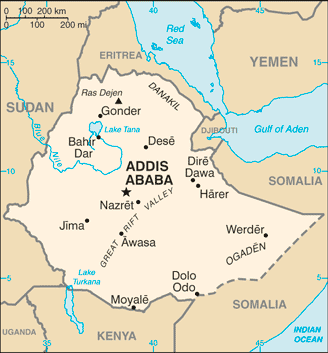By NewsDesk @infectiousdiseasenews
In a follow-up on a report on the chikungunya outbreak in Ethiopia, the number of cases has risen to 15,192 in the eastern city of Dire Dawa, according to French-China report.

Image/CIA
The Ethiopian Institute of Public Health (PHI) has so far reported 15,192 reports of Chikungunya patients, said Mesfin Wossen, interim director of the IHP, quoted by state-owned Ethiopia Broadcasting Corporation (EBC).
No fatalities have been reported.
Chikungunya Virus (CHIKV) is an arbovirus of the alphavirus genus (Togaviridae family) transmitted by the bite of infected Aedes mosquitoes. The word, Chikungunya, translates to “that which bends up”, based on the stooped position of patients during the rheumatic symptoms of the disease.
In humans bitten by an infected mosquito, the disease symptoms usually appear after an incubation period of three to seven days (range 1- 12 days).
The Perfect Predator: A Scientist’s Race to Save Her Husband from a Deadly Superbug: A Memoir
CHIKV can cause acute, sub-acute, and chronic disease.
In acute disease, symptoms develop abruptly and include high fever, headache, myalgia and arthralgia (predominantly in limbs and large joints). The appearance of a maculopapular rash is also frequent. Severe forms of the disease are rare. Symptoms usually resolve in 7-10 days, although arthralgia and joint stiffness may persist intermittently for several months.
The disease shares some clinical signs with dengue and Zika, and can be misdiagnosed in areas where they are common. As there is no cure, treatment is focused on relieving the symptoms.
Mystery disease in the Ivory Coast kills 28
Malaria: Burundi reports 112K cases in the week ending Aug 11, Annual death toll nears 2200


I am an Internist in kebri dehar regional hospital and Chikungunya disease was first seen around June in 2019 and there was a lot of patients who has seen in the hospital and and in the private clinics, without exaggeration the cases can reach more than 80,000 people. But it was not reported and I personally tried to communicate the RHB and no one listened to me. I heard on TV as it was reported only 60 case was seen and they said we have controlled it…I tell nothing was done here nothing.